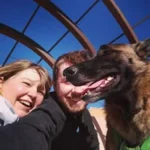- Episode One: How to Get Started with Training
- Episode Two: Lure/Reward
- Episode Three: Shaping
The Video
The Transcript
For our first trick, we’re teaching baby River to spin in a circle. Spin is a good trick to introduce lure/reward with, because it’s pretty easy for the dog to figure out, and pretty easy for people to get the hang of teaching.
Step one: Lure the dog
Put the treat in front of the dog’s nose, and get her to follow it into the position you want. When she does, say your marker word, or click your clicker, and give her the treat. This will hereafter be referred to as mark and reward. I’m using the marker word “yes” with River.
Some dogs won’t follow the treat at all at first. They might just stand there and stare blankly. They need to be taught how to play the “lure game” first. So, forget step one for now, and start with:
Step zero: Teach the lure game
Practice getting your dog to go after the lure. Wave it around, make encouraging noises. Any time the dog goes after it, even just moving her head towards it a little, praise and give her the treat. Over a few reps, increase the distance she has to move before she gets the treat. Once she’s enthusiastically chasing the lure, we can go back to…
Step one: Lure the dog
You might be able to get the whole behavior in one lure. Other dogs might have some trouble with that. Like with the spin trick, some dogs will get stuck partway through the turn. In that case, break it down a bit. Start by marking and rewarding for partial turns, gradually getting to the full spin.
Repeat this step enough that the dog is consistently following the lure into the correct position every time.
Don’t add the vocal cue yet. It probably feels like you should start saying the cue first, but that actually doesn’t come til later.
Step two: Fade the lure, add a hand signal
How many dogs do you know who will only do their tricks if there is a treat directly in front of their face? There is a very fine line between lure/reward and bribery. If you get stuck on the lure step too long, it becomes bribery.
So as quickly as possible, stop using a lure. After about two successful sessions of step one.
To start step two, you’re going to pretend you still have a treat in your hand. Make the exact same motion with your hand. When the dog does the thing, mark it, and reward with a treat from your other hand.
If she doesn’t follow your hand without the treat, you’re probably progressing too quickly. Go back to step one for a while.
With each successful repetition, you slowly make it more obvious that you’re not actually holding a treat.
Can I add the vocal cue yet? Nope, not yet. Not for this step. Not until…
Step three: Add the vocal cue
Okay, you chatty primate, now you can add the voice command, now that the dog is consistently following the hand signal every time.
You don’t want to add the vocal cue before the dog has a decent understanding of what you want. Otherwise, you risk the dog associating the cue with the wrong behavior.
This time, while the dog is following the hand motion, say the cue. As you do each rep of this step, the luring motion becomes less exaggerated, until it becomes the final hand signal.
What happens next -which I forgot to film, for some reason- is fading out the hand signal completely, if you want to. To do that, instead of pairing the vocal cue with the hand signal, start saying the vocal cue right before the hand signal.
The dog will figure out that the vocal cue predicts the hand signal, which prompts the behavior. Eventually you can cut out the “middle man” of the hand signal.



